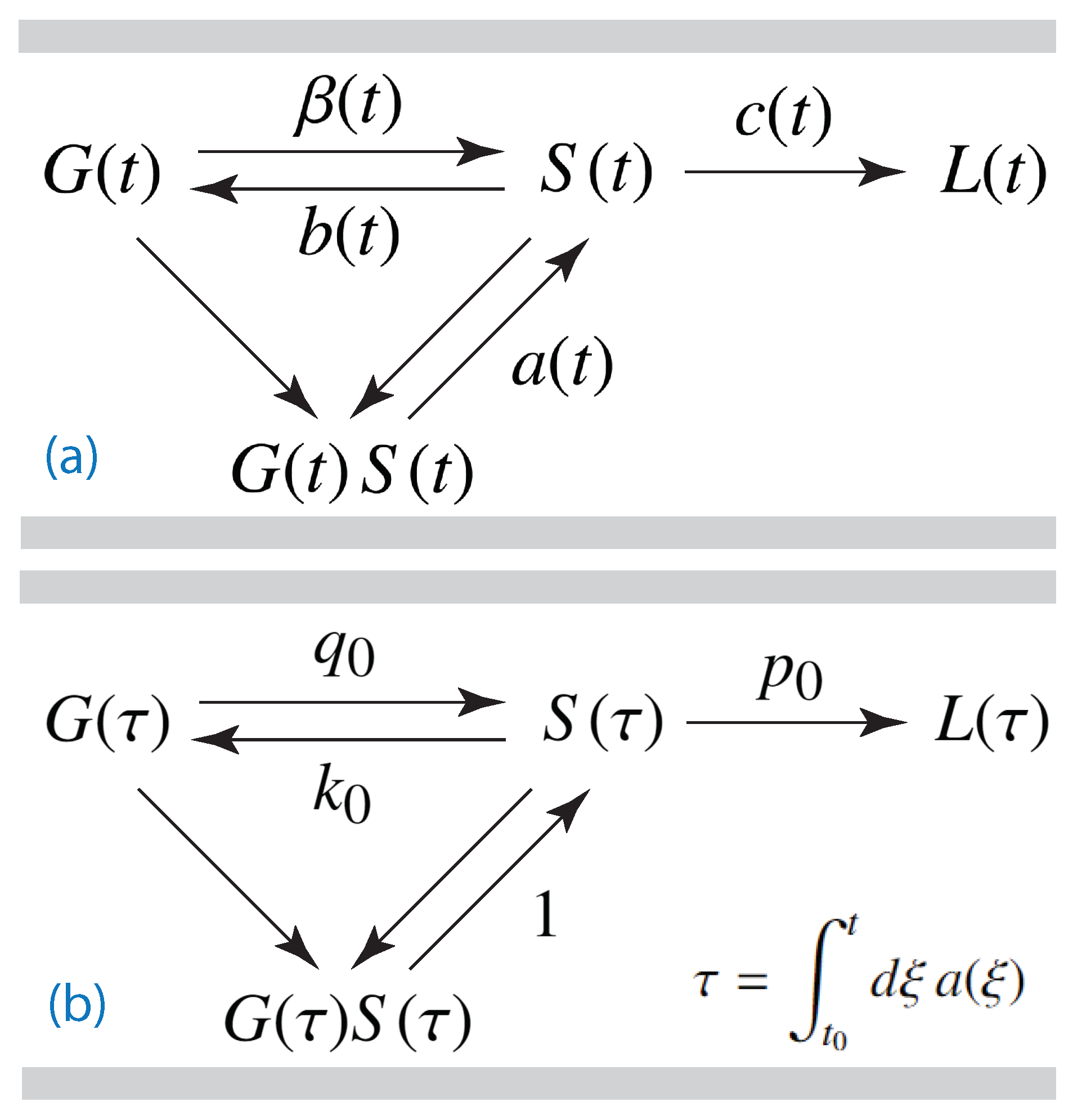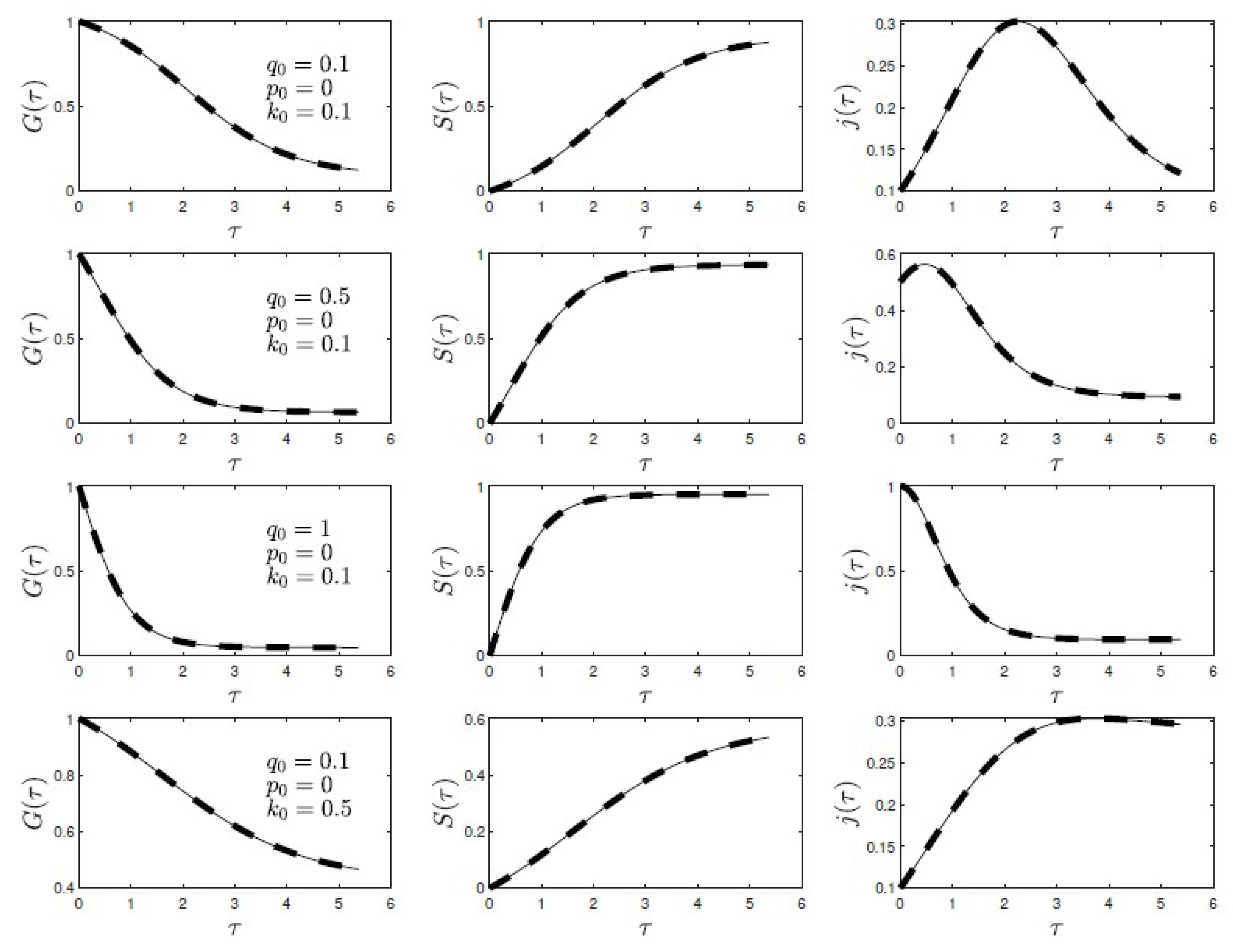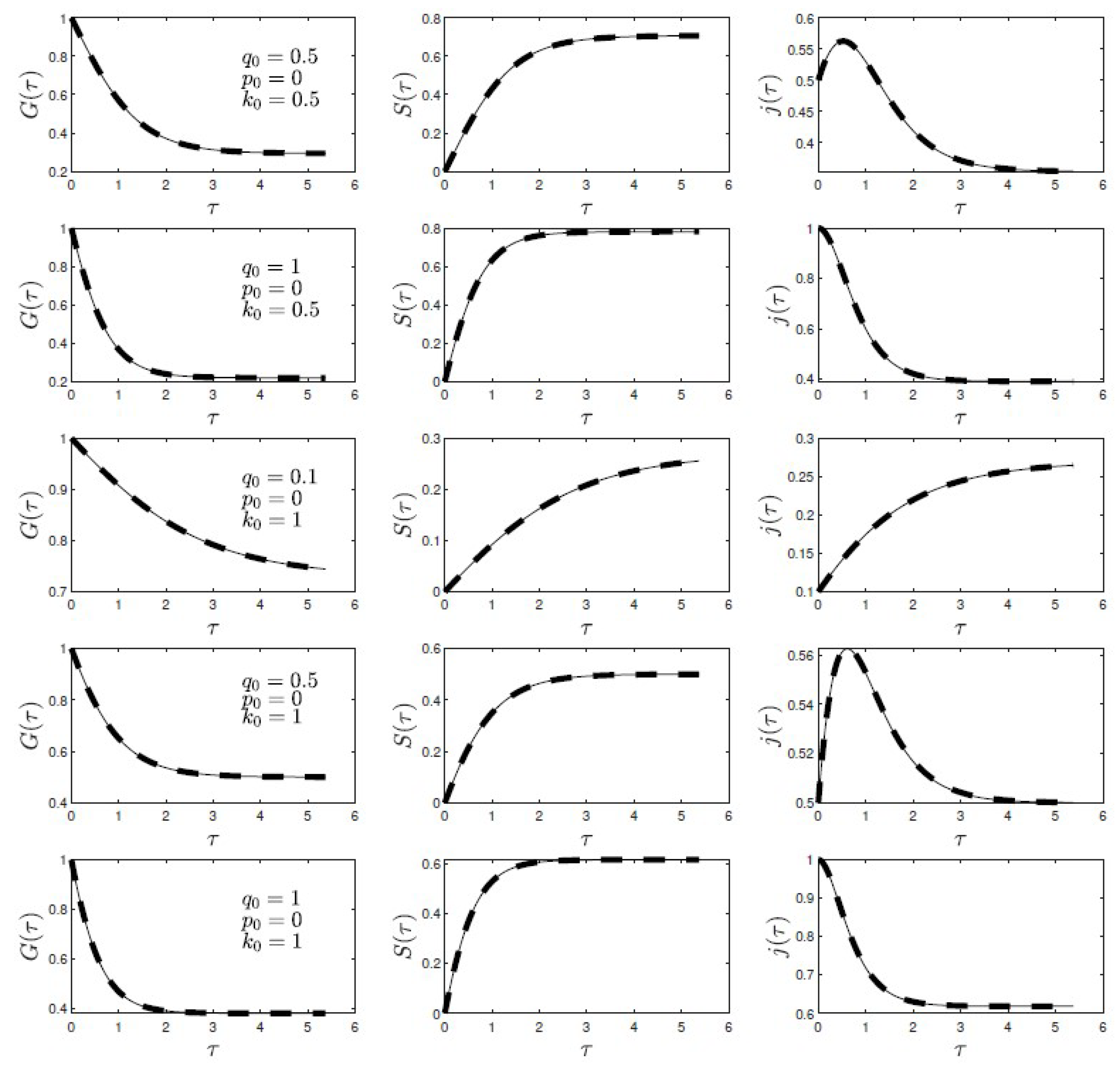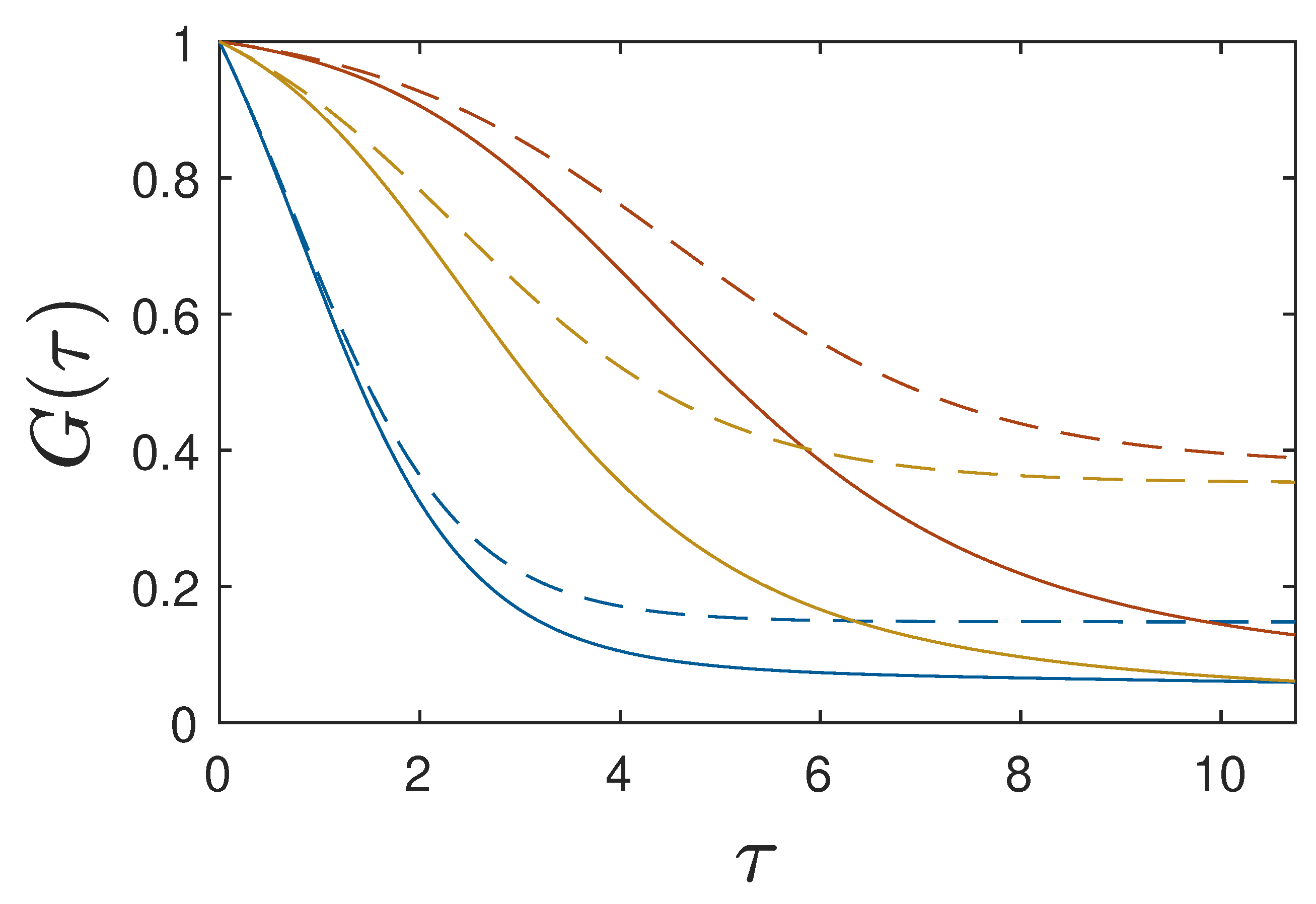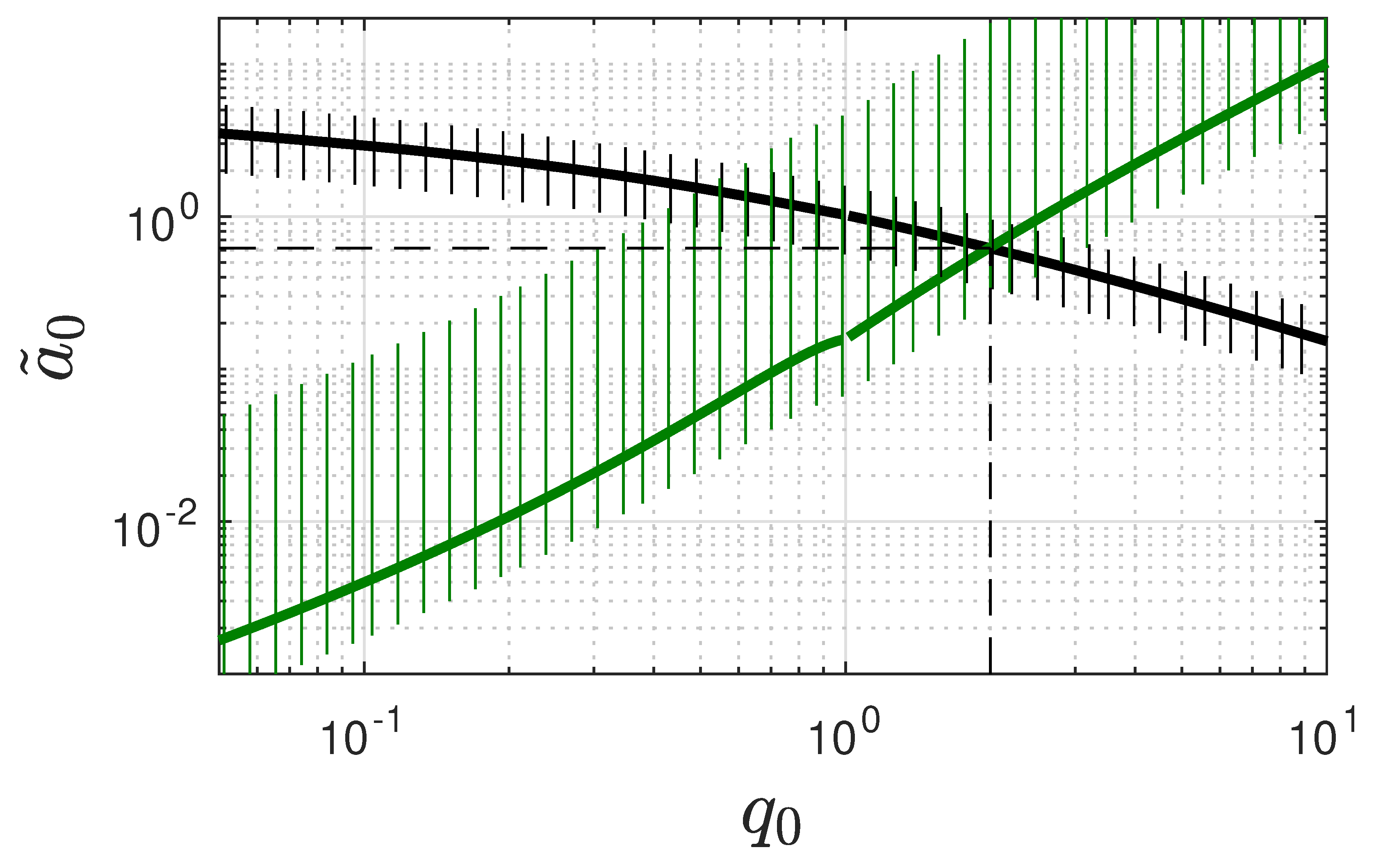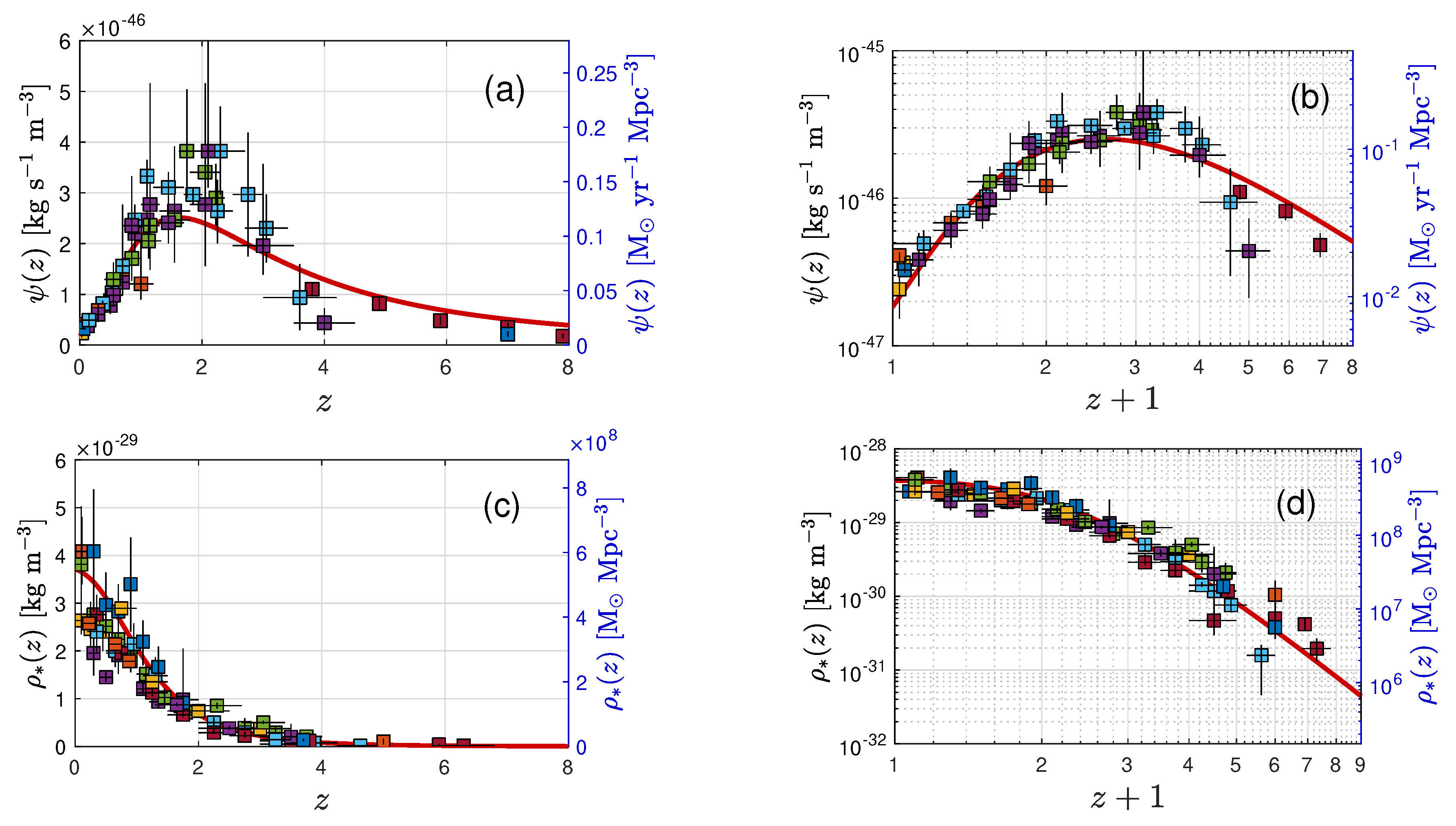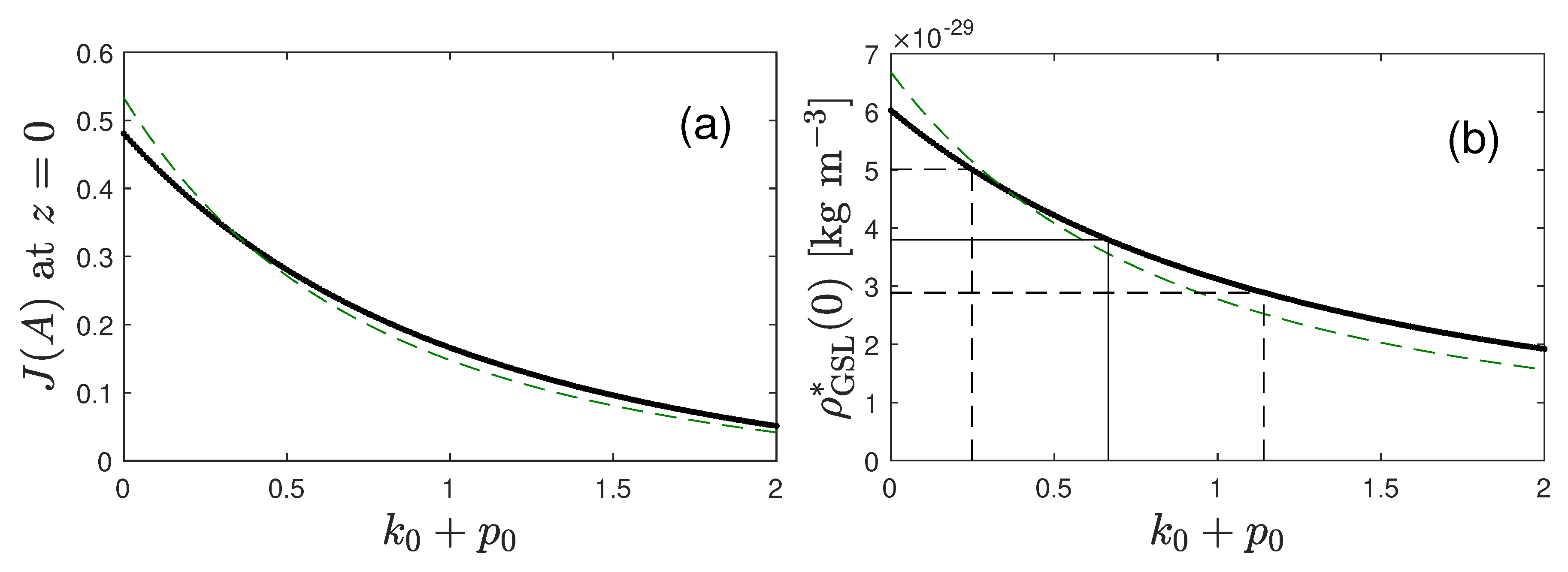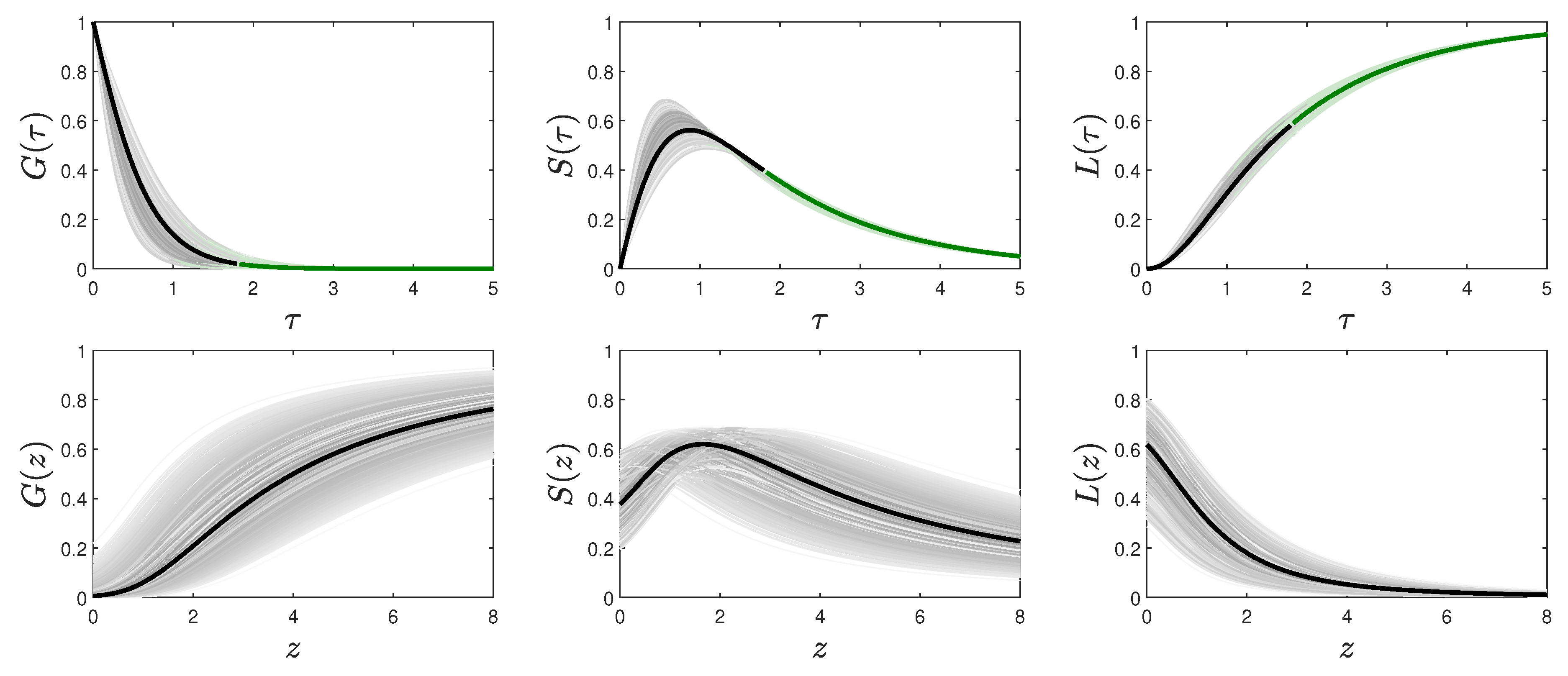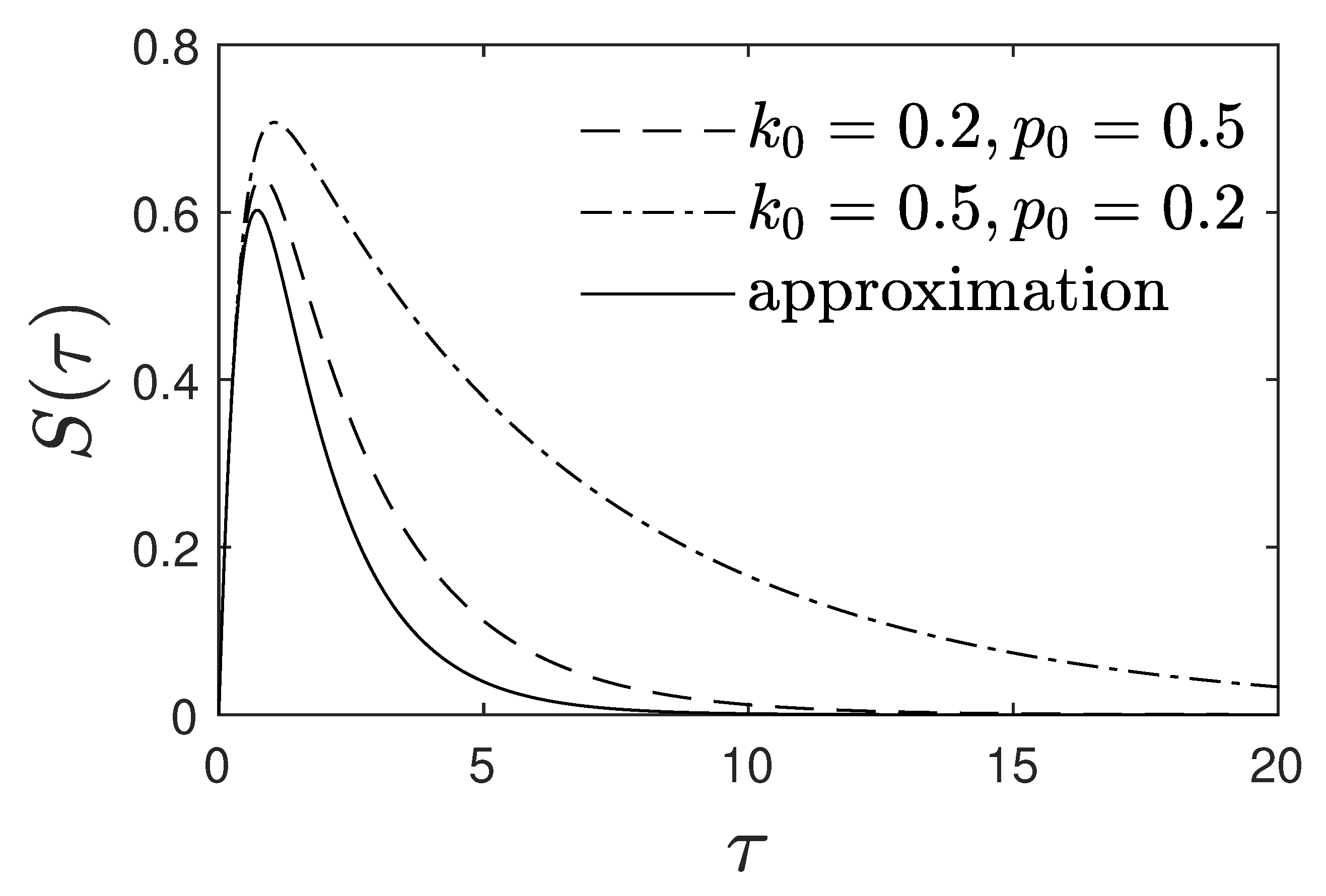1. Introduction
Recently ([
1] - hereafter referred to as part I) the compartmental description, well-known from the description of infection diseases and epidemics, has been introduced to describe the temporal evolution of the baryonic matter in interstellar gas and stars. Such a description makes use of gaseous and stellar fractions of the total baryonic matter and transition rates between these fractions. In particular, the respective rates of spontaneous (
) and triggered (
) star formation regulate the transfer
from gas to luminous main-sequence stars, whereas the stellar feedback rate (
) determines the feedback
from luminous stars to gas. Thirdly the stellar evolution rate (
) regulates the transfer
from luminous stars to locked-in stellar matter in the form of white dwarfs, neutron stars and black holes which are much less luminous and have no significant stellar feedback to the gaseous matter compartment.
In part I the process of triggered star formation has been ignored and the resulting exact analytical solutions for stationary rates of spontaneous formation, feedback and evolution have been compared with the observed cosmological star formation rate and the integrated stellar density. It has been demonstrated that the simplified GS-model ignoring stellar evolution cannot explain the observations. The comparison of the full gas-stars-locked-in (GSL) model including stellar evolution is more favorable but still far from being perfect. The non-perfect agreement of the GSL-model with only spontaneous star formation process therefore is a strong motivation to investigate the role of the additional triggered star formation process, which is the subject of the present part II.
Here, the competition of triggered and spontaneous star formation, stellar feedback and stellar evolution was theoretically investigated with analytical and numerical solutions of the nonlinear dynamical GSL equations. Following part I, baryonic matter exists as interstellar and intergalactic gas with the fraction and in two forms of stellar matter: denotes the fraction of luminous stellar matter in main-sequence stars while refers to the fraction of weakly luminous matter in white dwarfs, neutron stars and black holes (referred to as locked-in matter) which have no significant stellar feedback to the gaseous matter compartment. The temporal evolution of the three fractions is controlled by the respective rates of spontaneous star formation () and of triggered star formation ( of gas to stellar matter, of stellar feedback () of stellar to gaseous matter, and of the formation () of white dwarfs, neutron stars and black holes from stellar evolution. Obviously, the inclusion of triggered star formation introduces a nonlinearity in the GSL equations as it is depends on the product .
The organization of this manuscript is as follows. The GSL-compartmental model for the baryonic matter cycle is revisited in
Section 2. While
Section 3 is concerned with the GS-limit for negligible stellar evolution, the full GSL model for stationary ratios is investigated in
Section 4. Having obtained general relationships between the compartments, and their limiting, stationary values, approximate solutions are derived and tested in
Section 5.
Section 6 connects the GSL fractions with the cosmic star formation history and discusses observational constraints that help us identifying the parameters of the GSL model. The resulting redshift dependency of the gas and stellar fractions is presented in
Section 7. A summary and conclusions are provided in
Section 8.
3. GS-Limit for Negligible Stellar Evolution
In the case of vanishing stellar evolution,
, implying
at all times (
Figure 1). In that case the reduced GSL model Equations (
14a)–(14b) and (14d) simplified to the GS model equation
so that with Equations (
19) we obtained
Equation (
23a) readily provided
so that
Upon insertion of Equation (
25) the sum constraint (22c) became
or equivalently,
According to Equation (
27) the fraction
approaches a stationary value
at
, which is given by
where
Taking into account the initial conditions (
15), the solution of Equation (
27) could be written as
This integral evaluated to
or equivalently
The sum constraint (22c) then readily yielded
providing
Consequently, the dimensionless star formation rate (
17) became
where we recall that
and
are both known in terms of
and
. The maximum of
is attained at
solving
. This yielded the dimensionless peak time
as well, upon inserting
into Equation (28), the peak amplitude
where we made use of the definitions of
,
, and
according to Equation (28) to simplify the final expression. For the present case of
the analytical solutions (
32), (
33), (28) are shown to be identical with the numerical solution in Figure for various choices of
and
. Following [
2] the numerical solution of the GSL equations we obtained using the 10th order predictor–corrector Adams method ([
3,
4]). Within 0.1% precision, a single-step solver based on a modified Rosenbrock formula of order 2, implemented by [
5] as ode23s in Matlab
TM yielded practically indistinguishable results. The excellent agreement between the numerical and analytical solutions in Figure confirms the validity of our derivations.
6. Cosmic Star Formation History
As in part I we considered the cosmic star formation history (SFH) of the universe which is proportional to the star formation rate (
6). In the following the SFR density and the integrated stellar density using our results from the earlier
Section 5.3 are calculated, and compared with data collected by [
7].
According to Equations (I-46) and (I-47) as well as Equations (
9)–(
10) for general
the theoretical cosmic SFR density and the integrated stellar density as a function of redshift are
with
and
with
In part I we have argued that the factor
enters the calculation of
but not the calculation of the SFR density (
121) because all stars are born as luminous main sequence stars but only the fraction
contributes to the observed integrated density of luminous stars. Here we refined this reduction factor to
as also the baryonic gas does not contribute to the integrated luminous stellar density.
6.1. Observational Constraints
For the comparison with the predictions of the GSL-model we required the same five constraints as in part I.
First, the observed peak SFR density is given by ´
and occurs in the redshift range
([
8]) and
([
9]).
Secondly, we required for the observed peak redshift
As third constraint we used the observed integrated stellar mass density at
([
10,
11])
As fourth constraint we demanded that in order to have at least one maximum of at positive z. As fifth more stringent constraint we required that exhibits exactly one maximum within the redshift range .
6.2. SFR Density
Using Equation (
118) for
and Equation (
10) for
the SFR density (
121) became
This SFR density (128) fulfills the fourth and fifth constraint mentioned in the last
Section 6.1. With the first derivative
we found that a single maximum occurs at
given by the solution of the transcendental equation
while
Using the following abbreviations,
Equation (
130) simplified to
For values of
, corresponding to
, the positive solution of Equation (
133) with a maximum relative deviation of 0.9% from the exact solution is given by
where
is the numerical solution of
. Values
correspond to values of
. For values
, corresponding to values of
, the positive solution of Equation (
133) with a maximum relative deviation of 0.4% from the exact solution is given by
This approximation is exact at
and
, and compared with the numerical solution in
Figure 4. The cases
and
will be discussed in turn.
6.2.1. Values
With Equations (
10) and (134) we found for the peak time
the peak redshift
and the the peak SFR density
so that
Equating Equation (
137) with the observed peak redshift (
126) readily yielded
while the equality of Equation (
139) with the observed peak SFR density (125) lead to
Note that for
Equations (
140) and (
141) provide (
Figure 5)
which overlap very well.
6.2.2. Values
With Equations (
10) and (135) we obtained for the peak time
the peak redshift
and the peak SFR density
so that
Equating Equation (
144) with the observed peak redshift (
126) readily yielded
while the equality of Equation (
146) with the observed peak SFR density (125) lead to
All four expressions (
140)–(
141) and (
147)–(148) for
are displayed in
Figure 5. As parameter values consistent with the observational constraints values we inferred from
Figure 5
implying
Consequently, the spontaneous and triggered star formation processes operate on time scales of
Gyr and
Gyr, respectively. The partly large error bars resulted from the large error bars on the observed SFR peak density (125).
Note that for
the Equations (
147) and (148) provide
which agree perfectly with the earlier estimate (142). For very large values of
Equations (
147) and (148) yielded
In panels (a) and (c) of
Figure 6 we compared the theoretical SFR density (128) with the observations collected by [
7] where we varied freely the parameters
and
. As can be seen we obtained excellent agreement with the observations for the parameter choice
and
. Both values are consistent with the range of parameter values (
149) implied by the observational constraints discussed before. In panels (b) and (d) we show the corresponding fit to the observations of the integrated stellar density, to be discussed next. Here again we found excellent agreement if additionally the parameter values
and
so that
was chosen.
6.3. Integrated Stellar Density
Likewise, the integrated stellar density (123) is given by
where we used Equations (
10), (110) and (
118), substituted according to Equation (
132), and introduced the integral
6.3.1. Asymptotics of the Integral (154)
We investigated the asymptotic behavior of the integral (
154) for small values of
A with respect to unity, corresponding to large values of the redshift
z. We obtained
As
the asymptotics (155) corresponds to
with the characteristic redshift
of order unity. We then obtained for Equation (
153) in this limit
This asymptotic is significantly steeper than the
behavior obtained in part I for neglected triggered star formation.
In the alternative case of large arguments
the integral (
154) was approximated in
Appendix B as
6.3.2. Present-Day Integrated Stellar Density
For the present-day integrated stellar density at redshift
we note that with our earlier parameter estimates (
149)
is large compared to unity so that we used the approximation (159) providing for Equation (
153)
Equating the constraint (127) with Equation (
160) then yielded
In contrast with the earlier constraints (
140) and (
141) the constraint (
161) depends on the sum
of the additional ratios
and
characterizing the strength of stellar evolution and feedback, respectively. For
and
from Equation (
149), Equation (
161) yielded
in excellent agreement with the numerical fit in
Figure 7.
7. Redshift Dependency of the Gas and Stellar Fractions and Future of the Baryonic Universe
Here the best fit parameter values for the three ratios
,
and
and the triggered star formation rate
from the last Section were used to determine the present-day (
) gas and stellar fractions. The three panels in
Figure 8 display the resulting reduced time and redshift dependencies of the fractions using Equations (106), (110), and (120). The error bars according to Equations (
149) and
from the fits in
Figure 7 are represented as gray lines, whose darkness moderately increases with their probability, assuming Gaussian distributed
and
.
These panels not only show the history of the cosmological gas and stellar fractions as a function of redshift
z in panel (b), but also their future evolution as a function of the reduced time
in panel (a). Note that the present-day epoch depending on
corresponds to about
, so that future starts beyond this time. In panel (a) of
Figure 8 we marked the future epochs in green colour. It is clear, however, that ultimately at
the stationary state with values
is attained.
Next we considered the present-day (
) gas and stellar fractions. As present-day quantities have to be calculated, we used the modification
in Equations (
10)–(12) for
.
7.1. Present-Day Gas Fraction
According to Equation (
106) the Equation (
10) predicts for the present-day gas fraction
which can be contrasted with the observed Milky Way gas fraction of
([
12]). With the parameters (
149) we obtained for
Within the large error bars this prediction is consistent with the observed gas fraction of about 10 percent.
The gas fraction (
164) also provided the present-day interstellar gas mass to total (including locked-in matter) stellar mass
for the nominal parameter values
and
.
7.2. Stellar Fractions
Likewise, from Equation (110) we obtained
For the nominal values
,
,
, so that
, we found
for the ratio of the present-day interstellar gas mass to luminous stellar mass
The last ratio could be compared with the observed gas/stellar mass fraction in
galaxies ([
13,
14]) as the stellar component has been obtained from large galaxy surveys in the optical/infrared band where locked-in stellar matter contributes negligibly small emission. The observations reveal ratios as a function of stellar mass in the range
. The estimate (
168) is consistent with the observations but excluded the large positive error bar.
The estimates (
167) indicated that at the present time the majority of the baryons (more than 72 percent) resides in the form of stellar matter with
percent in locked-in stellar matter (white dwarfs, neutron stars and black holes) and
percent in the form of luminous main-sequence stars. These estimates had to be contrasted with expectations from stellar evolution models. In these models, for a reasonable choice of the initial mass function (see for example [
15,
16]), a stellar population of approximately 13 Gyr has only returned about
40% of its originally formed mass to the ISM, with
60% remaining as surviving stars or remnants. Of that ∼ 60%, only around ∼ 25% consists of remnants (white dwarfs, black holes, and neutron stars) — see section 2.1.2 of the review by [
17]. Within their uncertainties the estimates (
167) are consistent with the stellar evolution model calculations which have their own uncertainties.
7.3. Remarks
We can conclude this Section with two important remarks:
(1) It had not escaped from our attention that we can only constraint analytically the sum of the two parameters
from the comparison of the integrated stellar light as well as the stellar fractions. This is a drawback of our approximation of the exact Equation (
73): without the function
this equation indeed only involves the sum
. Therefore any dependence on the individual values of
and
only stems from the function
calculated in Equation (81). However, with the adopted relation (
83) involving only
, which with the choice (
84) then also depends only on the sum
, any dependency on the individual values of
und
was not possible anymore. This could be proven by comparing the exact numerical solutions of
for the two cases
and
) shown in
Figure 9. As in both cases the sum
is the same our approximation yielded the same time dependence of
, whereas the exact numerically calculated variations were different.
(2) The second remark concerns the value of the Hubble constant. In contrast to part I we here were in accord with all observational constraints for the standard value of the Hubble constant and did not have to speculate on substantially smaller values of the Hubble constant as in part I.
8. Summary and Conclusions
In this work we extended the analysis of the compartmental description of the temporal evolution of the baryonic matter in stars and interstellar gas, pioneered in part I, by the inclusion of the triggered star formation process. As in part I the introduction of gaseous and stellar fractions of the total baryonic matter as the basic dynamical variables is advantageous because it allows to apply the analysis to a variety of astrophysical systems. The competition of triggered and spontaneous star formation, stellar feedback and stellar evolution is theoretically investigated with analytical and numerical solutions of the nonlinear dynamical GSL equations for the interstellar and intergalactic gas fraction , the luminous stellar matter fraction , and the locked-in matter fraction .
By introducing the dimensionless reduced time variable
(
8) for arbitrarily but given time-dependent triggered SFR coefficient
, as well as the dimensionless ratios
,
and
, the derived exact solutions of the GSL equations for stationary ratios
,
and
hold for stationary rates as well as for the case of the same time-dependency of all rates. The accuracy of the analytical solutions is confirmed by comparison with the exact numerical solutions of the GSL equations. Once again of particular interest is the understanding of the cosmic star formation history, the present-day gas and stellar fraction, and their ultimate future fate with compartmental models. For a flat
CDM Friedmann cosmology the relationship between the reduced time variable
and the cosmological redshift
z is used to calculate the effect of redshift on the cosmological star formation rate, the integrated stellar density, and the present-day gas and stellar fractions. In contrast to part I the cosmological star formation rate now has two contributions from the spontaneous and triggered formation processes.
The inclusion of the nonlinear triggered star formation process enormously complicated the derivation of analytical solutions. Exact solutions of the GSL equations were derived in
Section 3 for the case of negligible stellar evolution and served an important dual purpose, namely to test the accuracy of the numerical code solving the GSL equations as well as comparing with the analytical approximations derived in the most general case in the respective limit of negligible stellar evolution. For the most general case of all four competing processes operating simultaneously with stationary ratios, we reduced the coupled dynamical GSL equations in
Section 3 to one exact nonlinear differential equation (see Equations (59) and (
73)) determining the time evolution for
from which the gas and stellar fractions can be determined. Approximate analytical solutions were derived in
Section 5 for the case of small times
and for general times for positive values of the ratio
characterizing the stellar evolution process. The small times solution in the case of negligible stellar evolution (
) holds at all times and agrees exactly with the earlier derived exact solutions in this special case in
Section 5. The accuracy of the approximate solution in the general case of finite
is demonstrated by comparison with the numerical solutions. Most noteworthy, for small enough rates of stellar feedback determining the ratio
the derived gas fraction and the formation rate (
118) of new stars as a function of the reduced time
are solely determined by the ratio
of spontaneous to triggered star formation, whereas the remaining two ratios
and
exhibit themselves in the temporal evolution of the stellar fractions
and
. This is in accord with the starting reduced GSL equations Equations (
14a) and (
17) that do not directly involve the ratio
.
The near independency of the formation rate (
118) of new stars as a function of the reduced time
significantly facilitates the calculation of the cosmological SFR as a function of redshift (
Section 6) which, for an adopted constant triggered star formation rate
, depends only on the two parameters
and
. The comparison with the observed SFR provides as best fit values
and
,
and
so that
. Due to the partly large uncertainties in the observed peak SFR rate the error bars on these parameters are
,
and
. In
Section 7 we calculated the resulting reduced and redshift dependencies of the three gas and stellar fractions. These not only show the history of the cosmological gas and stellar fractions as a function of redshift
z, but also predict their future evolution as a function of the reduced time
. Within the error bars the calculated present day gas and stellar fractions are consistent with the observed Milky Way gas fraction of 0.1 as well as the observed gas/stellar mass fraction in
galaxies. They also agree reasonably well with expectations from stellar evolution models.
As most important result of this investigation we found that the inclusion of the triggered star formation process explains the observed cosmological star formation rate and the integrated stellar density as well as the present-day gas and stellar fractions much better than the simplified GSL-model of part I ignoring triggered star formation. The best fit parameter values to the observations indicate that the spontaneous and triggered star formation processes dominate the dynamical evolution of baryonic matter in the universe indicated by the best-fit value of the sum of ratios being significantly smaller than unity. For an adopted constant triggered star formation rate , the spontaneous and triggered star formation processes operate on time scales of Gyr and Gyr, respectively. Interestingly, the spontaneous formation process is about twice more effective than the triggered formation process.
After the non-perfect agreement of the simplified GSL-model with only spontaneous star formation process investigated in part I, we can now conclude that the inclusion of the triggered star formation process has improved the situation significantly. This generalized GSL-model is consistent with all observational constraints from the cosmological star formation history and the corresponding integrated stellar density. The model provides excellent fits to the observed redshift dependencies of the star formation rate and the integrated stellar density. Moreover, it explains the observed present-day gas and stellar fractions in the universe, and it makes predictions on the future evolution of these fractions in the universe. The presented analysis of the GSL compartmental model has lead to new and original insights on the cosmological baryonic matter cycle in the universe.
